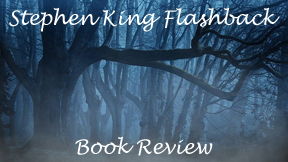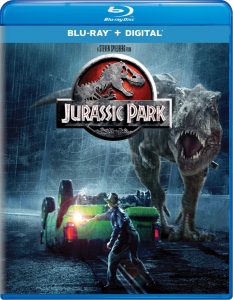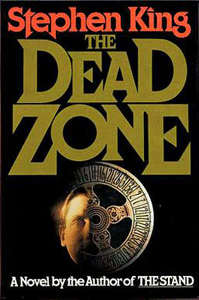I’ve always had a thing about carnivals and fairs – the hot summer night, the neon, and the false promises coalesce into something bittersweet. The feeling is even more extreme if you took a first date to a carnival, or were thinking about a girl you like as you walk the grounds.
A bittersweet symphony … that’s Johnny’s life
Stephen King’s “The Dead Zone” (1979) crystalizes that feeling – which, come to think of it, may be in my mind from my long-ago first read of the novel. Johnny Smith takes Sarah Bracknell to their local carnival in rural Maine and they have a wonderful evening where his psychic powers lead to roulette-wheel winnings.
Then things go south faster than the narrative of a Bruce Springsteen song, and hundreds of pages later, their love-story-that-doesn’t-quite-happen ends at a cemetery.

“The Dead Zone” (1979)
Author: Stephen King
Genre: Science fiction
Setting: 1970s, Maine and New Hampshire
Some might categorize “The Dead Zone” as horror because it’s Stephen King and Johnny has supernatural powers (he sees the future when he touches people or objects), as do the leads in “Carrie,” “The Shining” and “Firestarter” — all of which are horror.
A brainy novel
But really it’s a tragic love story with a touch of science fiction involving that most mysterious of things: the human brain. The sad romance hangs over the events like a rain cloud as Johnny loses a half-decade to a coma. He emerges to find Sarah has married another man. He can’t blame her for her pragmatic choice, but that only makes it more painful.
As always in his early works, King elevates a basic plot with rich details; here, we learn about the brain, and how a coma patient recovers – including surgeries to repair weakened tendons.
The author does his thing of introducing brand-new elements later in the novel. A schoolteacher before the car accident that put him in a coma, Johnny lands a job as a tutor of a smart teen with a reading disorder. So “The Dead Zone” is almost a bildungsroman.
Beware the populist candidate
Peppered throughout “The Dead Zone,” though, is a telegraphed plot that allows for a grand finale. We follow the political rise of Greg Stillson in New Hampshire’s third district. Johnny sees that Stillson will become president within the next 12 years and kick off World War III.
Stillson is both a blunt and memorable character – the scene of him charging across the stage like a ram stayed with me from my first read. King could’ve done more to make Stillson sympathetic and make “The Dead Zone” an across-the-board tragedy. The politician was abused as a child, but Stillson is above all a nasty villain. One particular chapter of behind-closed-doors brutalization will make you hate Stillson.

The Rise of Stillson arc is kind of prescient, kind of naïve when read today. King lightly warns of electing a populist candidate; I don’t know if the author had Reagan on his mind, but a modern reader will certainly think of Trump. He also warns of a media that gives passes to politicians they favor, which harkens to the Obama and Biden administrations.
When Johnny sees Stillson’s future evils, the age-old question of “If you had a time machine, would you kill Hitler?” becomes more than a thought exercise. Johnny decides his answer is “Yes.”
Stillson is no one’s guy
“The Dead Zone’s” ending is fatalistic, but it’s boosted by a twist where Johnny derails Stillson without shooting him. Here’s where King’s naivete comes into play. When Stillson holds up a baby as a shield (and, crucially, gets caught in a photograph), the electorate turns on him.
King didn’t envision the 21st century political environment where voters make excuses for “their guy.” Maybe it’s key that Stillson is an independent. Maybe it’s easy for people to say “Well, he was never our guy” since Stillson doesn’t represent a political party.
Still, I think King circa 1979 would’ve been surprised to find out how much the post-Carter presidents have gotten away with in the open. It was a different time: Johnny’s story unfolds throughout the 1970s, when Nixon resigned and the media was key to exposing his crimes.
A carnival of sights to see
“The Dead Zone” is a rich novel, with its palpable message that life ain’t fair, the medical details, and the refresher course on 1970s politics and King’s fears about the future of American governance. And I didn’t even mention the serial-killer mystery that keeps the middle portion churning along.
It’s also a long novel — 426 pages, but it reads longer because it has a tighter core of characters (almost everyone is linked to Johnny) and more inevitability than other thick texts like, say, “’Salem’s Lot.”
Another slight knock – or at least an oddity – is that the title doesn’t play into the events at all. The dead zone is the damaged part of Johnny’s brain that causes the psychic part to be activated in its stead. So Johnny can see the future, but as a price, some things – like numbers and locations – are forever lost in “the dead zone.”
The bigger prices, though, are paid by his emotional and physical health. In the short term, Johnny gets headaches when he sees the future. In the bigger picture, he lost Sarah and can’t live a normal existence.
As always in these “X-Men”-ish King novels, the “gift” is a curse. But more so than Carrie White or Charlie McGee, Johnny was cruising along toward a good life until he, well, became the lead in a Stephen King novel. So “The Dead Zone’s” punch lands that much harder.
On Fridays, RFMC reviews a Stephen King book, adaptation or related work. Click here to visit our Stephen King Zone.

